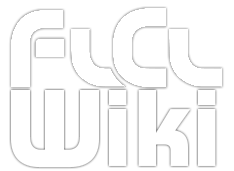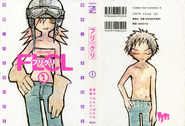A two-volume manga of FLCL was created by artist Hajime Ueda. The manga interprets the season with all of the key elements intact, and tells the events of the anime using a reductive art style and unsteady pacing. Jack Kotin defended the unique art style of the manga, saying, "It can be crudely drawn at times, but this style fits in well with the overall story and atmosphere...".[1]
The manga was published by Kodansha and serialized in monthly Magazine Z from December 25, 1999 – March 26, 2001. The two volumes were released on October 23, 2000, and August 23, 2001, respectively.[2][3] The manga was re-released in bunkoban format with the two volumes labeled First and Final in two individual box sets titled "Kodansha Box". The Jō volume was on May 7, 2007, and the Ge volume was released on June 4, 2007.[4][5] An edited tankōbon version of the manga that was released in box sets were released on January 10, 2012, and February 9, 2012, respectively.[6][7]
The English-language editions of the manga was released by Tokyopop on September 16, 2003 and on November 4, 2003 respectively.[8][9] In March 2011, Dark Horse Comics announced a re-release of the manga in omnibus edition.[10] The omnibus edition was released on May 16, 2012 and includes remastered story pages, a remastered script, and bonus color pages.[11]
Gallery[]
Trivia[]
- Despite having prominent role in the second-half of the OVA, both Commander Amarao and Kitsurubami only appear in a single panel with no speaking lines.
- Unlike in the OVA where Naota accidentally hits a robot clone of Kamon, he instead kills his actual father.
- Tasuku actually gets a speaking line unlike in the OVA, he calls Naota from a party telling him that he might come back and visit for New Years, even his American girlfriend gets a line as she briefly talks to Naota.






